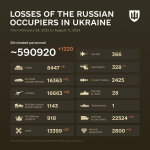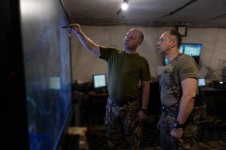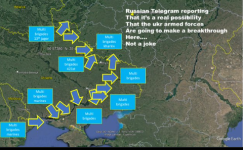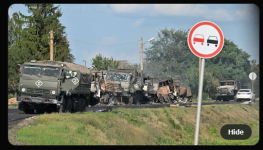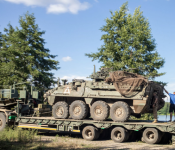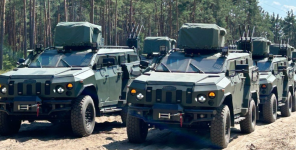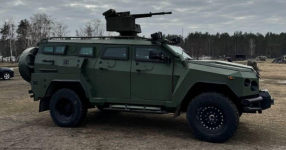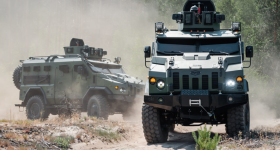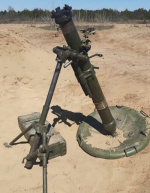ChloeTzang
Literotica Guru
- Joined
- Apr 14, 2015
- Posts
- 18,598
The only safe place for an F-16 in Ukraine is over the center of the country. Every minute spent on the ground increases the risk of detection and attack. It also wastes a precious asset. Much as airlines have discovered, it’s most efficient to keep aircraft working as much as possible, swapping out crews as needed until the maintenance schedule calls for an overhaul. Ukraine’s F-16s are older, but they have several years of hard flying left. Ukraine is likely to accelerate the acquisition of more modern combat jets going forward, so if the first few dozen are all lost or worn out by the end of 2025 it shouldn’t much matter. There are plenty of Vipers out there, but far fewer air and ground crews. It seems that a small squadron of ten is in service. Ukraine also appears to have gotten hold of static airframes to use as decoys, with sharp-eyed observers noting that the aircraft behind President Zelensky in the big photo op are old models. The ones that actually fly are former Danish jets.
Having Ukrainian jets shuttle between fields in central Ukraine solves both the need for distribution as well as the distance between Kyiv and the fronts. The official combat radius of an F-16 on a ground attack mission is a bit over 500km, but in an air combat configuration an 800-1,000km combat radius is possible. Combat radius is usually taken to mean the distance a jet can fly a given combat profile, spend up to fifteen minutes actively fighting, then return to base, so it along with most other aspects of range depend tremendously on the aircraft’s loadout and how the pilot chooses to fly. An F-16 flying out of Kyiv will eat up half its fuel getting to and from a patrol area set far enough behind the front to avoid coming under attack but close enough to engage within a few minutes of detecting an inbound threat. The basic operating pattern for the F-16s will look like a shuttle service. Only the most simple and speediest ground tasks will be handled at the forward bases to minimize the threat of drone or missile attack.
A two-ship Viper flight can leave Kyiv, patrol for an hour over the Dnipro, then land at separate bases to refuel, rearm, and swap pilots in a bunker. In under half an hour the jets will be turned around like a pit stop at a racetrack and sent back up. When aircraft is operated for long enough that it needs maintenance spanning several hours, it can cycle back to Kyiv for work in an underground shelter. When major work needs to be done the aircraft can shuttle back to Poland. In theory, ten aircraft in the inventory could mean that Ukraine perpetually keeps two in the sky with another two ready to take off. Two more will be recovering from a mission, a fourth pair preparing to fight, with the fifth in maintenance. Any aircraft not available within a day can be replaced by one stored abroad. That would mean that every one of the twelve or so Viper pilots in Ukraine goes up twice every twenty-four hours until more arrive. Historically speaking this isn’t an extreme load, especially if the mission profile is usually fairly simple and keeps pilots over friendly territory.
U.S. Navy aircraft carrier operations are a useful rough guide to what will prove sustainable. They boast the ability to maintain over 300 sorties a day for several in a row, or 150-200 for up to six months. They carry seventy aircraft, meaning that each flies two to three times a day, but likely enough pilots that each only flies once. Carrier operations are notoriously taxing, forcing a pilot to land on a surface that’s always moving in multiple dimensions. So a 24/7 patrol cycle appears doable, if difficult. It might not seem like much to have only two jets airborne and another pair ready to scramble, but each pair can theoretically take down a dozen orc cruise missiles. How many hospitals or schools will that save? More than none, which is why this counts as a big win even if Ukraine can’t go actively hunting Sukhois for a while. In September the number of trained Ukrainian pilots should roughly double. By the new year they’ll hopefully have doubled again, reaching 40-50, though it’s difficult to be certain going by news reports. There has been a lot of talk in the American press about how few pilots Ukraine will have and the limited number of aircraft it can use at once. But everything is relative, and the US media is an active participant in shaping perceptions about Ukraine. Not necessarily, sad to say, for the benefit of Ukraine.
No one should expect spectacular dogfights. In a successful encounter a Ukrainian F-16 pair will be alerted to an inbound suspected glide bomb attack while they’re cruising high over the Dnipro to conserve fuel. They’ll dump their spare fuel tanks and dive to treetop level, accelerating past the speed of sound. Around 40km from the front they’ll pitch up in a zoom climb lasting up to a minute and release missiles, then dive back to the deck and run for safety. Even if detected and targeted during the climb, if the nearest orc shooter is 120km away a nimble little jet like an F-16 equipped with a modern anti-missile system should stand a very good chance of evading. There are always risks. But soldiers in the trenches accept their own. In war, everybody gets their share. I’m not focusing on the F-16’s ground attack capabilities (or the 20mm cannon mentioned in nearly every media piece for no apparent reason but to sound technical) because for the time being its main value is securing the sky. That’s the form of close air support that Ukrainian soldiers need most.
Vipers are the best hope Ukraine has of stopping the glide bombs. Hitting orc airfields is always good, the the hard truth is that Moscow has a lot of them. It can distribute its own operations at the cost of making them less efficient. What it can’t do is replace more than one or two combat losses each month, even if Moscow is happily evading US-led sanctions. F-16s are another crucial piece in the jigsaw puzzle of winning the war in Ukraine.
And from now on, every time orc aviators take to the sky, they’ll wonder if this flight will be their last. Soon they’ll learn what it’s like to be hunted.
Having Ukrainian jets shuttle between fields in central Ukraine solves both the need for distribution as well as the distance between Kyiv and the fronts. The official combat radius of an F-16 on a ground attack mission is a bit over 500km, but in an air combat configuration an 800-1,000km combat radius is possible. Combat radius is usually taken to mean the distance a jet can fly a given combat profile, spend up to fifteen minutes actively fighting, then return to base, so it along with most other aspects of range depend tremendously on the aircraft’s loadout and how the pilot chooses to fly. An F-16 flying out of Kyiv will eat up half its fuel getting to and from a patrol area set far enough behind the front to avoid coming under attack but close enough to engage within a few minutes of detecting an inbound threat. The basic operating pattern for the F-16s will look like a shuttle service. Only the most simple and speediest ground tasks will be handled at the forward bases to minimize the threat of drone or missile attack.
A two-ship Viper flight can leave Kyiv, patrol for an hour over the Dnipro, then land at separate bases to refuel, rearm, and swap pilots in a bunker. In under half an hour the jets will be turned around like a pit stop at a racetrack and sent back up. When aircraft is operated for long enough that it needs maintenance spanning several hours, it can cycle back to Kyiv for work in an underground shelter. When major work needs to be done the aircraft can shuttle back to Poland. In theory, ten aircraft in the inventory could mean that Ukraine perpetually keeps two in the sky with another two ready to take off. Two more will be recovering from a mission, a fourth pair preparing to fight, with the fifth in maintenance. Any aircraft not available within a day can be replaced by one stored abroad. That would mean that every one of the twelve or so Viper pilots in Ukraine goes up twice every twenty-four hours until more arrive. Historically speaking this isn’t an extreme load, especially if the mission profile is usually fairly simple and keeps pilots over friendly territory.
U.S. Navy aircraft carrier operations are a useful rough guide to what will prove sustainable. They boast the ability to maintain over 300 sorties a day for several in a row, or 150-200 for up to six months. They carry seventy aircraft, meaning that each flies two to three times a day, but likely enough pilots that each only flies once. Carrier operations are notoriously taxing, forcing a pilot to land on a surface that’s always moving in multiple dimensions. So a 24/7 patrol cycle appears doable, if difficult. It might not seem like much to have only two jets airborne and another pair ready to scramble, but each pair can theoretically take down a dozen orc cruise missiles. How many hospitals or schools will that save? More than none, which is why this counts as a big win even if Ukraine can’t go actively hunting Sukhois for a while. In September the number of trained Ukrainian pilots should roughly double. By the new year they’ll hopefully have doubled again, reaching 40-50, though it’s difficult to be certain going by news reports. There has been a lot of talk in the American press about how few pilots Ukraine will have and the limited number of aircraft it can use at once. But everything is relative, and the US media is an active participant in shaping perceptions about Ukraine. Not necessarily, sad to say, for the benefit of Ukraine.
No one should expect spectacular dogfights. In a successful encounter a Ukrainian F-16 pair will be alerted to an inbound suspected glide bomb attack while they’re cruising high over the Dnipro to conserve fuel. They’ll dump their spare fuel tanks and dive to treetop level, accelerating past the speed of sound. Around 40km from the front they’ll pitch up in a zoom climb lasting up to a minute and release missiles, then dive back to the deck and run for safety. Even if detected and targeted during the climb, if the nearest orc shooter is 120km away a nimble little jet like an F-16 equipped with a modern anti-missile system should stand a very good chance of evading. There are always risks. But soldiers in the trenches accept their own. In war, everybody gets their share. I’m not focusing on the F-16’s ground attack capabilities (or the 20mm cannon mentioned in nearly every media piece for no apparent reason but to sound technical) because for the time being its main value is securing the sky. That’s the form of close air support that Ukrainian soldiers need most.
Vipers are the best hope Ukraine has of stopping the glide bombs. Hitting orc airfields is always good, the the hard truth is that Moscow has a lot of them. It can distribute its own operations at the cost of making them less efficient. What it can’t do is replace more than one or two combat losses each month, even if Moscow is happily evading US-led sanctions. F-16s are another crucial piece in the jigsaw puzzle of winning the war in Ukraine.
And from now on, every time orc aviators take to the sky, they’ll wonder if this flight will be their last. Soon they’ll learn what it’s like to be hunted.
